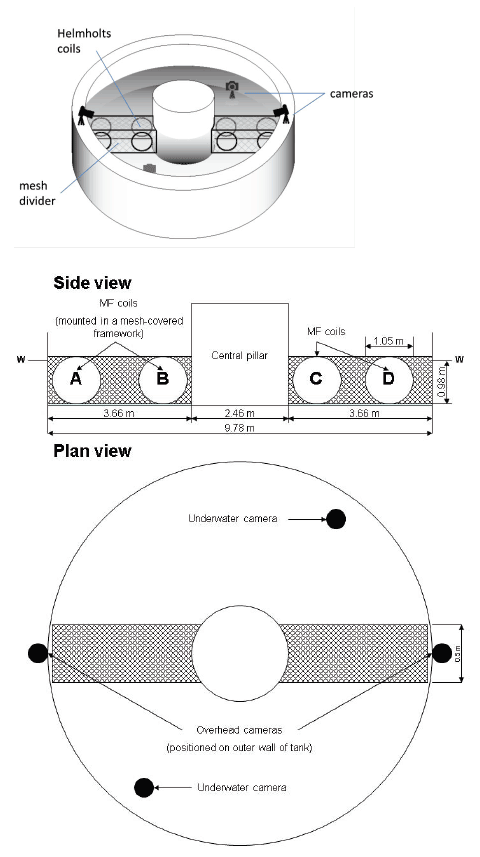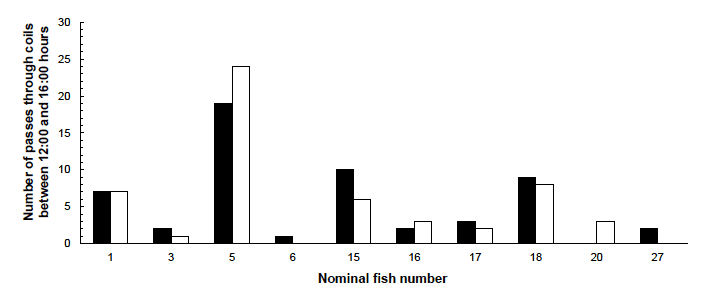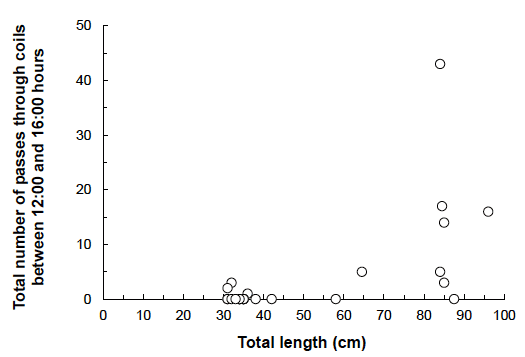Scottish Marine and Freshwater Science Vol 6 No 8: Effects of AC Magnetic Fields (MFs) on Swimming Activity in European Eels Anguilla anguilla
Report investigating the effects of AC magnetic fields on European eels. DOI: http://dx.doi.org/10.7489/1618-1
References
Aarestrup, K., Thorstad, E.B., Koed, A., Jepsen, N., Svendsen, J.C., Pedersen, M.I., Skov, C. & Økland, F. (2008). Survival and behaviour of European silver eel in late freshwater and early marine phase during spring migration. Fisheries Management and Ecology 15, 435-440.
Aarestrup, K., Økland, F., Hansen, M.M., Righton, D., Gargan, P., Castonguay, M., Bernatchez, L., Howey, P., Sparholt, H., Pedersen, M.I. & McKinley, R.S. (2009). Oceanic spawning migration of the European eel ( Anguilla anguilla). Science 325, 1660.
Als, T.D, Hansen, M.M., Maes, G.E., Castonguay, M., Riemann, L., Aarestrup, K., Munk, P., Sparholt, H., Hanel, R. & Bernatchez, L. (2011). All roads lead to home: panmixia of European eel in the Sargasso Sea. Molecular Ecology 20, 1333-1346.
Armstrong, J.D., Braithwaite, V.A. & Huntingford, F.A. (1997). Spatial strategies of wild Atlantic salmon parr: exploration and settlement in unfamiliar areas. Journal of Animal Ecology 66, 203-211.
Armstrong, J.D., Huntingford, F.A. & Herbert, N.A. (1999). Individual space use strategies of wild juvenile Atlantic salmon. Journal of Fish Biology 55, 1201-1212.
Bevelhimer, M.S., Cada, G.F., Fortner, A.M., Schweizer, P.E. & Riemer, K. (2013). Behavioural responses of representative freshwater fish species to electromagnetic fields. Transactions of the American Fisheries Society 142, 802-813.
Boehlert, G.W. & Gill, A.B. (2010). Environmental and ecological effects of ocean renewable energy development: a current synthesis. Oceanography 23, 68-81.
Churchward, A. & Shelley, J. (2004). Atlantic salmon Salmo salar. In: Freshwater fishes in Britain. Compiled and edited by: Davies, C.E., Shelley, J., Harding, P.T., McLean, I.F.G., Gardiner, R. & Peirson, G. Harley Books, Colchester.
CMACS (2003). A baseline assessment of electromagnetic fields generated by offshore windfarm cables. COWRIE Report EMF - 01-2002 66. Centre for Marine and Coastal Studies, University of Liverpool, U.K.
Frid, C., Andonegi, E., Depestele, J., Judd, A., Rihan, D., Rogers, S.I. & Kenchington, E. (2012). The environmental interactions of tidal and wave energy generation devices. Environmental Impact Assessment Review 32, 133-139.
Gill, A.B. (2005). Offshore renewable energy: ecological implications of generating electricity in the coastal zone. Journal of Applied Ecology 42, 605-615.
Gill, A.B. & Bartlett, M. (2010). Literature review on the potential effects of electromagnetic fields and subsea noise from marine renewable energy developments on Atlantic salmon, sea trout and European eel. Scottish Natural Heritage Commissioned Report No. 401.
Gill, A.B., Gloyne-Phillips, I., Neal, K.J. & Kimber, J.A. (2005). The potential effects of electromagnetic fields generated by sub-sea power cables associated with offshore wind farm developments on electrically and magnetically sensitive marine organisms - a review. COWRIE-EM FIELD 2-06-2004.
Gill, A.B., Huang, Y., Gloyne-Philips, I., Metcalfe, J., Quayle, V., Spencer, J. & Wearmouth, V. (2009). COWRIE 2.0 Electromagnetic Fields (EMF) Phase 2: EMF-sensitive fish response to EM emissions from sub-sea electricity cables of the type used by the offshore renewable energy industry. Commissioned by COWRIE Ltd (project reference COWRIE-EMF-1-06).
Gill, A.B., Bartlett, M. & Thomsen, F. (2012). Potential interactions between diadromous fishes of U.K. conservation importance and the electromagnetic fields and subsea noise from marine renewable energy developments. Journal of Fish Biology 81, 664-695.
Gill, A.B, Gloyne-Philips, I., Kimber, J. and Sigray, P. (2014). Marine renewable energy, electromagnetic (EM) Fields and EM-sensitive animals. In: Shields, M.A. and Payne, A.I.L. Marine Renewable Energy Technology and Environmental Interactions. Springer, Dordrecht.
He, P. & Wardle, C.S. (1988). Endurance at intermediate swimming speeds of Atlantic mackerel, Scomber scombrus L., herring, Clupea harengus L., and saithe, Pollachius virens L. Journal of Fish Biology 33, 255-266.
Inger, R., Attrill, M.J., Bearhop, S., Broderick, A.C., Grecian, W.J., Hodgson, D.J., Mills, C., Sheehan, E., Votier, S.C., Witt, M.J. & Godley, B.J. (2009). Marine renewable energy: potential benefits to biodiversity? An urgent call for research. Journal of Applied Ecology 46, 1145-1153.
IUCN (2009). IUCN Red List of Threatened Species. Available at http://www.iucnredlist.org/
JNCC (2007). Biodiversity Action Plan Priority Species List. Available at http://jncc.defra.gov.uk/PDF/UKBAP_Species-HabitatsReview-2007.pdf
Malcolm, I.A., Godfrey, J. & Youngson, A.F. (2010). Review of migratory routes and behaviour of Atlantic salmon, sea trout and European eel in Scotland's coastal environment: implications for the development of marine renewables. Scottish Marine and Freshwater Science Volume 1, No. 14.
Öhman, M.C., Sigray, P. & Westerberg, H. (2007). Offshore windmills and the effects of electromagnetic fields on fish. Ambio 36, 630-633.
Olsson, T., Bergsten, P., Nissen, J. & Larsson, A. (2010). Impact of electric and magnetic fields from submarine cables on marine organisms - the current state of knowledge. Vattenfall Ocean Energy Programme, Project Number 3080100 Final Report. 67pp.
Scottish Government (2011). 2020 Routemap for Renewable Energy in Scotland. The Scottish Government, Edinburgh. Available at http://www.scotland.gov.uk/Resource/Doc/917/0118802.pdf
Tesch, F.W., Wendt, T. & Karlsson, L. (1992). Influence of geomagnetism on the activity and orientation of the eel, Anguilla anguilla (L.), as evident from laboratory experiments. Ecology of Freshwater Fish 1, 52-60.
Westerberg, H. & Begout-Anras, M.-L. (2000). Orientation of silver eel ( Anguilla anguilla) in a disturbed geomagnetic field. In: A. Moore & I. Russell (eds) Advances in Fish Telemetry. Proceedings of the 3rd Conference on Fish Telemetry. Lowestoft: CEFAS, pp. 149-158.
Westerberg, H. & Lagenfelt, I. (2008). Sub-sea power cables and the migration behaviour of the European eel. Fisheries Management and Ecology 15, 369-375.
Figure 1 Schematic, side, and plan views of the annular tank in which the experiment took place. The tank was filled to a point just below the top of the mesh-covered framework (to the level marked "W") to ensure fish had to swim through one of the four MF coils in order to move around the tank.
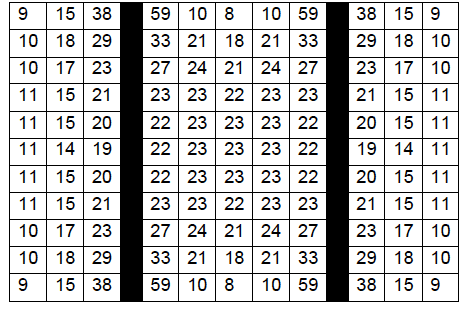
( b)
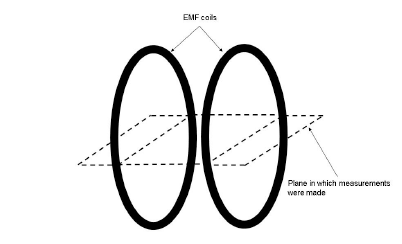
Figure 2 ( a) Schematic top view of the shape of the MF generated by a single pair of coils. Numbers in squares show the MF strength measured in each 10 x 10 cm grid square relative to the positions of the MF generator coils (black vertical bars). Measurements were made in air and are given in µT using an AC input of 2 V (0.2 A) for calibration purposes at the time of installation. Measurements in ( a) were made in the plane represented by the dashed lines in ( b). Note that the MF extended in front of and behind the coils, and that MF strength diminished to approximately 50 % of the maximum when 30 cm in front of or behind the coils.
Figure 3 The number of passes made by "swimmers" ( n = 10) through coils during the 4-hour period between 12:00 and 16:00 hours according to status of the coils (active â- ; inactive â-¡).
Figure 4 Scatterplot to show the relationship between the total number of passes through coils during the 4-hour period between 12:00 and 16:00 hours and eel size, expressed as total length ( LT, cm).
Table 1 Details of eels used in the experiment.
| Coils A and B | Coils C and D | ||||||||
|---|---|---|---|---|---|---|---|---|---|
| Experiment phase |
Nominal fish number |
Trial date | First coils activated |
LT (cm) |
Swimming status |
Passes when active |
Passes when inactive |
Passes when active |
Passes when inactive |
| 1 | 1 | 19/01/2012 | A and B | 85 | Swimmer | 7 | 0 | 0 | 7 |
| 1 | 2 | 24/01/2012 | C and D | 58 | Non-swimmer | 0 | 0 | 0 | 0 |
| 1 | 3 | 25/01/2012 | A and B | 85 | Swimmer | 1 | 1 | 1 | 0 |
| 1 | 4 | 26/01/2012 | C and D | 42 | Non-swimmer | 0 | 0 | 0 | 0 |
| 1 | 5 | 27/01/2012 | A and B | 84 | Swimmer | 19 | 0 | 0 | 24 |
| 1 | 6 | 30/01/2012 | C and D | 36 | Swimmer | 1 | 0 | 0 | 0 |
| 1 | 7 | 31/01/2012 | A and B | 34 | Non-swimmer | 0 | 0 | 0 | 0 |
| 1 | 8 | 01/02/2012 | C and D | 31 | Non-swimmer | 0 | 0 | 0 | 0 |
| 1 | 9 | 02/02/2012 | C and D | 38 | Non-swimmer | 0 | 0 | 0 | 0 |
| 1 | 10 | 06/02/2012 | C and D | 35 | Non-swimmer | 0 | 0 | 0 | 0 |
| 1 | 11 | 07/02/2012 | A and B | 35 | Non-swimmer | 0 | 0 | 0 | 0 |
| 1 | 12 | 09/02/2012 | C and D | 35 | Non-swimmer | 0 | 0 | 0 | 0 |
| 2 | 13 | 21/08/2012 | A and B | 31 | Non-swimmer | 0 | 0 | 0 | 0 |
| 2 | 14 | 23/08/2012 | C and D | 34 | Non-swimmer | 0 | 0 | 0 | 0 |
| 2 | 15 | 28/08/2012 | A and B | 96 | Swimmer | 5 | 2 | 5 | 4 |
| 2 | 16 | 30/08/2012 | C and D | 84 | Swimmer | 0 | 3 | 2 | 0 |
| 2 | 17 | 04/09/2012 | A and B | 65 | Swimmer | 0 | 0 | 3 | 2 |
| 2 | 18 | 06/09/2012 | C and D | 85 | Swimmer | 0 | 8 | 9 | 0 |
| 2 | 19 | 13/09/2012 | A and B | 88 | Non-swimmer | 0 | 0 | 0 | 0 |
| 2 | 20 | 20/09/2012 | C and D | 32 | Swimmer | 0 | 3 | 0 | 0 |
| 2 | 21 | 26/09/2012 | A and B | 35 | Non-swimmer | 0 | 0 | 0 | 0 |
| 2 | 22 | 27/09/2012 | C and D | 34 | Non-swimmer | 0 | 0 | 0 | 0 |
| 2 | 23 | 02/10/2012 | A and B | 34 | Non-swimmer | 0 | 0 | 0 | 0 |
| 2 | 24 | 04/10/2012 | C and D | 35 | Non-swimmer | 0 | 0 | 0 | 0 |
| 2 | 25 | 08/10/2012 | A and B | 34 | Non-swimmer | 0 | 0 | 0 | 0 |
| 2 | 26 | 09/10/2012 | C and D | 32 | Non-swimmer | 0 | 0 | 0 | 0 |
| 2 | 27 | 10/10/2012 | A and B | 31 | Swimmer | 2 | 0 | 0 | 0 |
| 2 | 28 | 16/10/2012 | C and D | 33 | Non-swimmer | 0 | 0 | 0 | 0 |
Contact
There is a problem
Thanks for your feedback
